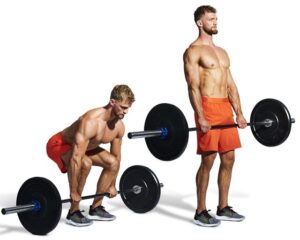Introduction: The deadlift stands as a cornerstone of strength training, a fundamental exercise that epitomizes raw power and full-body engagement. As one of the “big three” lifts alongside the squat and bench press, the deadlift holds a revered place in weightlifting circles for its ability to build overall strength, improve posture, and develop functional power. Whether you’re a seasoned lifter striving to hit new personal records or a novice looking to master proper form, understanding the intricacies and benefits of the deadlift is essential. In this introduction, we’ll delve into the mechanics, variations, and key benefits of the deadlift, unlocking its potential to transform your strength training journey.
Types of deadlift variations:
- Conventional Deadlift: The classic deadlift variation where you stand with your feet hip-width apart, grip the barbell with hands outside your knees, and lift the weight from the floor to a standing position. It primarily targets the lower back, hamstrings, glutes, and grip strength.
- Sumo Deadlift: In this variation, you assume a wide stance with toes pointed outward, and your hands grip the barbell inside your legs. The sumo deadlift reduces the range of motion for some lifters and places more emphasis on the quadriceps and adductor muscles.
- Romanian Deadlift (RDL): Unlike the traditional deadlift where the weight starts from the floor, the RDL involves a partial range of motion. You begin in a standing position, hinge at the hips while keeping your back straight, lower the barbell towards the ground, and then return to the starting position. It targets the hamstrings and glutes while emphasizing hip hinge mechanics.
- Trap Bar Deadlift: Using a specialized hexagonal trap bar, this deadlift variation allows you to stand inside the barbell with a more neutral grip. It’s often seen as more joint-friendly and can engage the quadriceps and glutes slightly differently compared to the conventional deadlift.
- Deficit Deadlift: Involves standing on a platform or elevated surface, which increases the distance between you and the barbell. This variation enhances the range of motion, requires greater mobility and strength, and emphasizes leg drive and grip strength.
- Snatch Grip Deadlift: With a wide grip similar to the snatch lift in Olympic weightlifting, this variation increases the difficulty and places more emphasis on upper back, traps, and grip strength. It’s beneficial for improving pulling strength and shoulder stability.


Ways to increase the deadlift: mentioning few exercises and techniques from pool of many.
- Rack pulls
- Deficit deadlift
- front squats
- grip strength
- warm up
Rack pull: The rack pull is a weightlifting exercise that exudes power and intensity. Picture a sturdy metal rack, loaded with heavy plates, standing in a bustling gym filled with the rhythmic clinks of iron. The lifter approaches, their muscles already primed with anticipation. With a firm grip on the barbell, they set their stance, feet planted like anchors on the ground. As they begin to lift, the sound of the plates scraping against each other reverberates through the air. The bar rises steadily, guided by sheer determination and strength
Deficit deadlift: The deficit deadlift is a weightlifting technique that brings a unique challenge and depth to the traditional deadlift exercise. Imagine a lifter standing on a sturdy platform, their feet positioned on plates that elevate them above the ground. This added height creates a deficit between the lifter and the barbell, intensifying the range of motion and engaging muscles in a more profound way. As the lifter grasps the barbell with a determined grip, their focus sharpens, ready for the demanding lift ahead. With a deep breath, they engage their core and leg muscles, driving their heels into the ground with force.
In conclusion, incorporating a variety of strategies and techniques can significantly enhance your deadlift performance and overall strength. By focusing on proper form, progressively overloading, incorporating accessory exercises, addressing weak points, and optimizing recovery, you can unlock your full potential in the deadlift. Remember to listen to your body, stay consistent with your training, and continually challenge yourself to push past plateaus.
Credits: Mens health, myUpchar